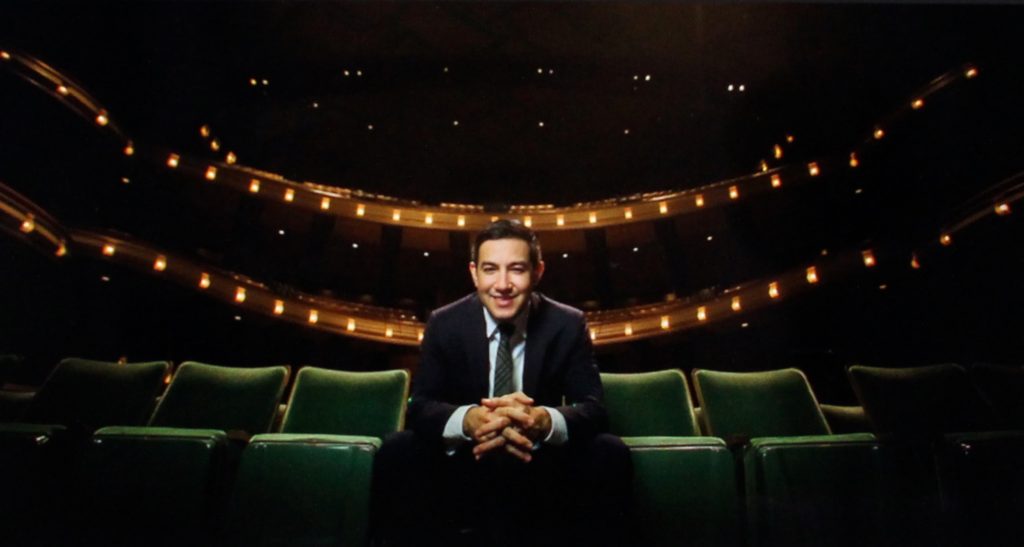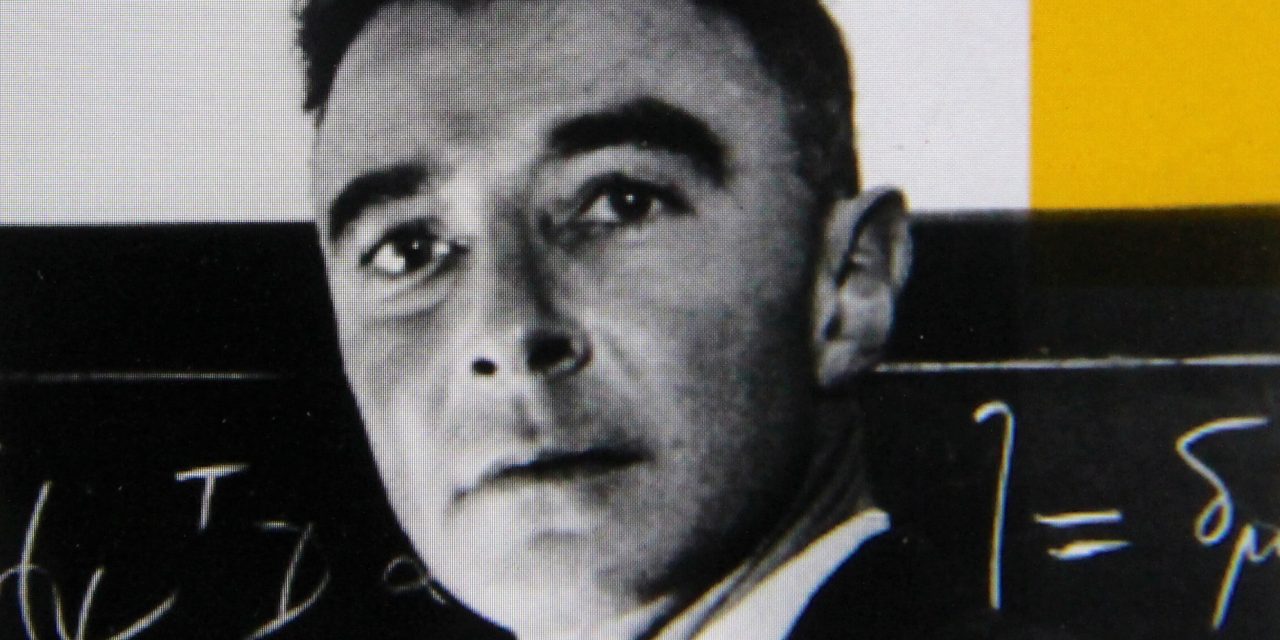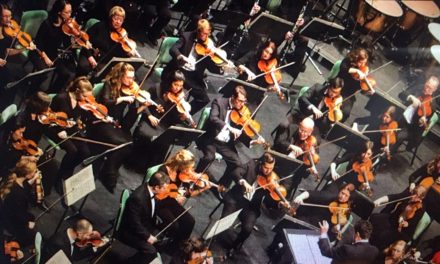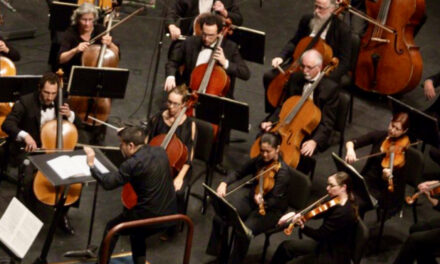(Above: Robert Oppenheimer, one of the developers of the atomic bomb, experienced emotional conflict at the overwhelming responsibility that composer John Adams first turned into an opera, Dr. Atomic, then recast as a 24-minute symphony to be performed now by the Eugene Symphony)
By Randi Bjornstad
A musical composition about the building and testing of the atomic bomb may sound like a strange premise, but for Eugene Symphony conductor Francesco Lecce-Chong, raising the baton to begin the orchestra’s performance of the symphony titled Dr. Atomic will be a dream — yet also a bit of a nightmare — come true.
“It is hard to categorize Dr. Atomic, but for me, it is the most important piece of the last 25 years,” Lecce-Chong said. “I promised myself 10 years ago that in my first season of developing a program as a conductor, it would be included.”
And so it will. Lecce-Chong took the podium as Eugene’s maestro during the 2017-18 symphony season, but that musical lineup was already in place. The 2018-19 season is where his indelible imprint on the musical program has begun to appear.

Dr. Atomic “is probably 24 minutes of some of the most awe-inspiring but terrifying music I have ever encountered,” he said enthusiastically in a weekend telephone interview. “It’s extracted from a three-hour opera that John Adams wrote about the psyche of Robert Oppenheimer and the people around him during the hours leading up to the testing of the atomic bomb, and what that process does to all of them. It’s crushing in a way.”
In fact, experiencing the opera for the first time “had a profound effect on me,” Lecce-Chong said. “I thought so much about it and felt so affected by it that afterward I couldn’t even sleep.”
Dr. Atomic in symphony form is a fraction of the original 2005 Adams opera that had its premiere in San Francisco that year and was named by New York Times reviewer Anthony Tommasini as “the musical event of the year in America.”
Two years later, Adams began his first symphony adaptation of the work, which originally took 45 minutes and included four movements, but which he later reduced to three movements in under 25 minutes, which is the version the Eugene Symphony will play at its March 21 concert.
“The music that opens and closes the opera also is what opens and closes the symphony,” Lecce-Chong said. “The second movement, which is called Panic, recalls a massive thunderstorm that happened on the night that the test was scheduled to take place.”
That movement in particular is a huge challenge for both the musicians and the conductor.
“The strings are just running up and down for five minutes, but every second of that is all tied tightly together and has to be exact — it’s just insane,” Lecce-Chong said. “But our musicians are such professionals, no one would ever sit there and say, ‘I can’t do this.’ Do they really love it? I don’t know, but I’m sure they will be glad when they finish.”
Besides the challenge to the strings, “There also will be lots of big brass solos, which represent the characters singing arias in the opera version,” he said.
Taking on a piece like Dr. Atomic is a perfect example of “the moments when we grow together as a group,” Lecce-Chong said. “We work very hard, and we get to know each other better.”
However, there was another major hurdle in putting this particular symphony program together, Lecce-Chong said: What in the world do you play alongside Dr. Atomic?
“The problem is, you can’t end a program with Dr. Atomic, but how do you follow it up?” he said. “You can’t do something frivolous, but you have to give the audience some relief after that intensity.”
After much thought, he selected Johannes Brahms’ Violin Concerto.
“I think it’s just perfect, because Dr. Atomic ends with a pulsing, driving D-minor chord, and although the Brahms is written in D-major, it enters with a D-minor chord,” he said. “So I think it allows us to acknowledge where we have just been, and it lets have a feeling that we can restore beauty to the world.”
He’s also thrilled that the Brahms piece will feature an 18-year-old, up-and-coming guest violinist, Julian Rhee, whom he considers “just spectacular.”
As for what should precede the angst of Dr. Atomic, Lecce-Chong has chosen Robert Schumann’s Manfred Overture, based on the poem of that name by George Gordon Byron, aka Lord Byron.
Byron began his poem, which contains elements of the supernatural that were popular in English literature in the early 19th century, in 1816. Schumann made it the basis for his musical overture in 1852.
The premise of the poem is the anguish experienced by a man, Manfred, who lives with a sense of overwhelming guilt for some horrible offense he has committed and who attempts unsuccessfully to conjure up powerful spirits to allow him to give him some peace.
In that sense, the Schumann fits perfectly as a lead-in to the Adams piece, Lecce-Chong said, as it musically explores the torment that people always have felt as they made choices that they might come to regret but nonetheless must live with to the end.
As for the uncanny juxtaposition of performing the Dr. Atomic symphony even as the use of nuclear weapons looms large over current international politics, Lecce-Chong said that’s really a coincidence.
“I made the promise to myself 10 years ago that I would conduct this symphony at the first opportunity, and this is it,” he said. “It was timely then, and it is timely now.
For better or for worse, he said, “It is the world we live in.”
Dr. Atomic & Brahms
When: 7:30 p.m. on Thursday, March 21
Where: Silva Concert Hall, Hult Center for the Performing Arts, One Eugene Center (Seventh and Willamette streets in downtown Eugene)
Tickets: $25 to $60 (additional handling fees may apply), available at the Hult Center box office, 541-682-5000, or online at hultcenter.org/









